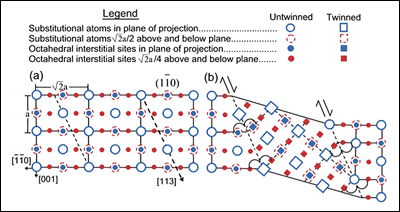Gregory Oberson
Professor S. Ankem
When most people think of titanium alloys, products like biomedical implants, golf clubs, and aircraft come to mind. The titanium alloys within those products are crystalline materials that impart high strength, low density, corrosion resistance and biocompatibility. A significant effort is underway to understand titanium alloys better and expand their industrial and commercial uses.
One problem that has bedeviled engineers is that titanium alloys will deform over time, even under relatively low stresses, at room temperature. This phenomenon is called "room-temperature creep," and it can reduce titanium alloy performance.
Think about a large airplane with titanium alloy landing gear. After thousands of hours supporting the weight of the aircraft, the landing gear may begin to deform, albeit at very low creep rates, increasing maintenance costs and reducing safety.
Until recently, such deformation has been poorly understood. Now, significant findings by graduate student Greg Oberson and Associate Professor Sreeramamurthy Ankem of the Clark School's Department of Materials Science and Engineering shed new light on the creep deformation of titanium alloys‚ and, in fact, on creep deformation in a wide range of materials with important roles in everything from geological systems to high-temperature superconductors.

[Projection of bcc substitutional and octahedral interstitial atoms onto (110) plane. 9a) Untwinned structure showing direction of [113] twinning sheer, and (b) final twinned structure showing mirror symmetry across twin-matrix interface.]
Oberson and Ankem propose that the slow growth of "deformation twins" in titanium alloys is one of the mechanisms responsible for room-temperature creep deformation. (Ankem was the first to show that deformation twins can grow very slowly during creep deformation, and not at the speed of sound, as was generally believed.) They propose that twin growth in titanium alloys is hindered by the presence of oxygen impurity atoms in the interstitial sites (i.e., gaps) of the crystal: the titanium atoms cannot move to their twinned positions until the oxygen impurities have diffused to another location in the crystal. Their research suggests that by processing titanium alloys to alter their chemistry or microstructure, it will be possible to develop creep-resistant titanium components, improving the alloys' performance and increasing the range of potential applications.
Oberson and Ankem describe their work in their article, "Why twins do not grow at the speed of sound all the time," to be published in the prestigious journal, Physical Review Letters (Vol. 95, No. 16). (View the article online at Physical Review Letters)
Twinning occurs in a wide range of crystalline materials including metals, ceramics, intermetallics, nanocrystalline materials, geological systems and even high-temperature superconductors. These materials are of interest in various fields of engineering including electrical, mechanical, civil and aerospace. The new findings by Oberson and Ankem will help researchers in these fields develop advanced materials for a variety of applications.
Top